Jacob Jordaens
Jacob (Jacques) Jordaens (19 May 1593 – 18 October 1678[1]) was a Flemish painter, draughtsman and tapestry designer known for his history paintings, genre scenes and portraits. After Peter Paul Rubens and Anthony van Dyck, he was the leading Flemish Baroque painter of his day. Unlike those contemporaries he never travelled abroad to study Italian painting, and his career is marked by an indifference to their intellectual and courtly aspirations.[2] In fact, except for a few short trips to locations in the Low Countries, he remained in Antwerp his entire life.[2] As well as being a successful painter, he was a prominent designer of tapestries.[3]
Jacob Jordaens | |
|---|---|
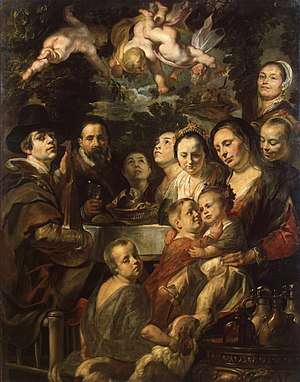 Self-Portrait with Parents, Brothers, and Sisters (c. 1615). Oil on canvas. The Hermitage, St. Petersburg, Russia | |
| Born | 19 May 1593 |
| Died | 18 October 1678 (aged 85) |
| Nationality | Flemish |
| Known for | Painting |
| Movement | Flemish Baroque |
Like Rubens, Jordaens painted altarpieces, mythological, and allegorical scenes, and after 1640—the year Rubens died—he was the most important painter in Antwerp for large-scale commissions and the status of his patrons increased in general.[4] However, he is best known today for his numerous large genre scenes based on proverbs in the manner of his contemporary Jan Brueghel the Elder, depicting The King Drinks and As the Old Sing, So Pipe the Young.[1] Jordaens' main artistic influences, besides Rubens and the Brueghel family, were northern Italian painters such as Jacopo Bassano, Paolo Veronese, and Caravaggio.[2]
Biography
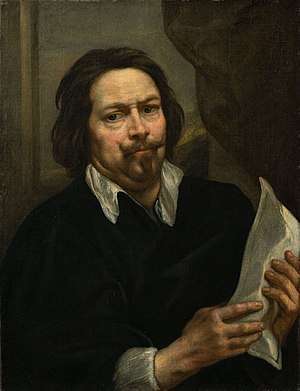
Jacob (Jacques) Jordaens was born on 19 May 1593, the first of eleven children, to the wealthy linen merchant Jacob Jordaens Sr. and Barbara van Wolschaten in Antwerp.[5] Little is known about Jordaens' early education. It can be assumed that he received the advantages of the education usually provided for children of his social class. This assumption is supported by his clear handwriting, his competence in French and in his knowledge of mythology. Jordaens familiarity with biblical subjects is evident in his many religious paintings, and his personal interest with the Bible was strengthened by his later conversion from Catholicism to Protestantism.[6]
Like Rubens, he studied under Adam van Noort, who was his only teacher. During this time Jordaens lived in Van Noort's house in the Everdijstraat and became very close to the rest of the family.[7] After eight years of training with Van Noort, he enrolled in the Guild of St. Luke as a "waterschilder", or watercolor artist.[6] This medium was often used for preparing tapestry cartoons in the seventeenth century.[8] although examples of his earliest watercolour works are no longer extant. In the same year as his entry into the guild, 1616, he married his teacher's eldest daughter, Anna Catharina van Noort, with whom he had three children. In 1618, Jordaens bought a house in Hoogstraat (the area in Antwerp that he grew up in). He would then later buy the adjoining house to expand his household and workspace in 1639, mimicking Rubens' house built two decades earlier. He lived and worked here until his death in 1678.[9]
Jordaens never made the traditional trip to Italy to study classical and Renaissance art. Despite this, he made many efforts to study prints or works of Italian masters available in northern Europe. For example, Jordaens is known to have studied Titian, Veronese, Caravaggio, and Bassano, either through prints, copies or originals (such as Caravaggio's Madonna of the Rosary). His work, however, betrays local traditions, especially the genre traditions of Pieter Bruegel the Elder, in honestly depicting Flemish life with authenticity and showing common people in the act of celebratory expressions of life.[10] His commissions frequently came from wealthy local Flemish patrons and clergy, although later in his career he worked for courts and governments across Europe. Besides a large output of monumental oil paintings he was a prolific tapestry designer, a career that reflects his early training as a "watercolour" painter.[5]
Jordaens' importance can also be seen by his number of pupils; the Guild of St. Luke records fifteen official pupils from 1621 to 1667, but six others were recorded as pupils in court documents and not the Guild records, so it is probable that he had more students than officially recorded. Among them were his cousin and his son Jacob. Like Rubens and other artists at that time, Jordaens' studio relied on his assistants and pupils in the production of his paintings. Not many of these pupils went on to fame themselves,[11] however a position in Jordaens' studio was highly desirable for young artists from across Europe.[12]
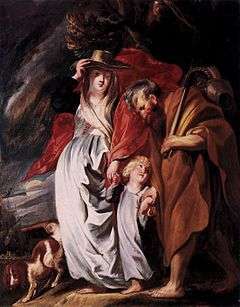
Influence of Rubens
Jordaens was greatly influenced by Peter Paul Rubens who occasionally employed him to reproduce small sketches in a larger format. After the death of Rubens, Jordaens advanced to the position of one of the most admired painters in Antwerp.[13] Like Rubens, Jordaens relied on a warm palette, naturalism, and a mastery of chiaroscuro and tenebrism. Jordaens was only moderately successful as a portrait painter but excelled in representations of the base character of humanity. His classically inspired peasant themes and large-scale moralistic genre scenes influenced Jan Steen. Although Jacob Jordaens did not specialize, he often repeated a theme based on a proverb that depicted a wide range of characters of a variety of ages, crowded in a festive scene around a banquet table. These humorous pieces have a sense of coarseness.[5] While Jordaens drew upon Rubens' motifs throughout his career, his work is differentiated by a tendency to greater realism, a crowding of the surface of his compositions, and a preference for the burlesque, even within the context of religious and mythological subjects.[13] Prometheus, c. 1640 is an example of the influence of both Rubens and Frans Snyders on Jacob Jordaens. While he drew inspiration from their collaboration Prometheus Bound, c. 1611–12, Jordaens' version is a more hopeful narrative.
Subjects
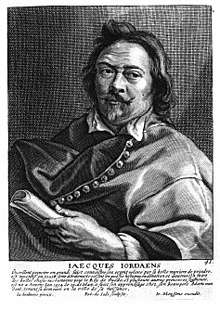
In addition to being a well-known portrait painter, Jordaens also employed his pencil in biblical, mythological, and allegorical subjects and even etched a number of plates. Although primarily a history painter, he also painted illustrations of Flemish proverbs, such as the "Old Sing so the Young Twitter", and depictions of Flemish festivals, for example "The King Drinks."[5] Several of his works hint at a passion for animal painting. He often included a variety of animals, most likely drawn from life, including cows, horses, poultry, cats, dogs, and sheep. His life drawings of both animals and people were used and referenced throughout his life.[14] After Rubens' death in 1640 Jordaens became Antwerp's new leading artist.[15] Only after achieving this status did Jordaens receive royal commissions, predominantly from the north.[5] He also received a commission from Ruben's heirs to finish a Hercules and an Andromeda for Philip IV of Spain.
In 1635–40, when Rubens was ill from gout, Jordaens was commissioned to use Rubens' sketches, and work on the decorations for the triumphal entry of the Cardinal-Infante Ferdinand, the new Governor of the Spanish Netherlands, for his arrival in Antwerp in 1635. Although the works are lost, Jordaens was commissioned in 1639–40 by Charles I of England to finish decorating the Queen's House at Greenwich, a commission which was originally given to Rubens, who was unable to execute due to his poor health.[5]
Jordaens also played his part in a collaborative effort to decorate the Torre de la Parada, done between 1636 and 1681.[16] Two works in the series attributed to Jordaens are Apollo and Pan (1637), made after a sketch by Rubens, and Vertummus and Pomona (1638).[16] Further contributions debated include Fall of the Titans, Marriage of Peleus and Thetis, and Cadmus Sowing the Dragons Teeth.[16] In 1661, he was asked to paint three, fairly large lunettes for the newly constructed Amsterdam Town Hall.[5]
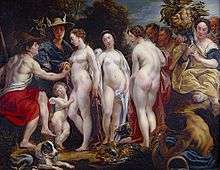
At the end of Jordaens' career between 1652 and 1678 his creative and artistic ability had deteriorated. He moved from vibrant colours to a gray-blue palette, accented at times with a dull brown, and applied paint so thinly that the canvas could be seen. However, there were few exceptions to this (such as the aforementioned religious paintings he produced after he had converted to Protestantism), most notable being the History of Psyche that he did for his own house.[5]
Religion
The Protestant religion was forbidden in Antwerp, which at the time was still Spanish-occupied territory. Towards the end of his lifetime Jordaens converted to Reformed Protestantism, but continued to accept commissions to decorate Catholic churches.[5][17] Jordaens was fined 200 pounds and 15 shillings for scandalous or heretical writings between 1651 and 1658.
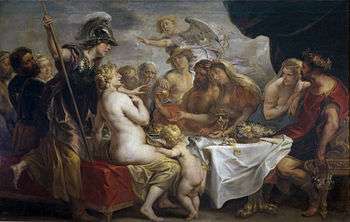
Death and burial
Jordaens died of the mysterious Antwerp disease ('zweetziekte' or 'polderkoorts' in Dutch) in October 1678, which, on the same day, also killed his unmarried daughter Elizabeth, who had lived with him. Their bodies were buried together under one tombstone in the Protestant cemetery at Putte, a village just north of the Belgium border, where his wife Catharina had been put to rest earlier. A monument was erected in Putte in 1877, dedicated to and containing the tombstones of Jordaens and two of his painting colleagues, Simon de Pape (I) and Adriaan van Stalbemt. It stands on the location of the little Protestant church and cemetery, both of which were demolished years earlier. The bust on top of the monument was made by Jef Lambeaux.
One year after his death, Jacob Jordaens' son donated "twenty-five Flemish pounds to the Camer van den Huysarmen in Antwerp."[5] Also included in this donation was The Washing and Anointing of the Body of Christ which was given to an orphanage of girls. Apparently this was all done in following correspondence with a will that Jacob Jordaens left behind, a document yet to be found.[5] Even without the finding of Jordaen's will, his kindness has been recognized by those who knew him. There are many other found documents that note his admiration by others.
Works
The Adoration of the Shepherds
_-_Nationalmuseum_-_17491.tif.jpg)
The Adoration of the Shepherds (1616, 1618) depicts the Virgin Mary preparing to suckle the Christ Child while He is adored by Flemish-looking shepherds. The scene is limited to five figures who, with the exception of Christ, are shown in half length emphasizing the intimacy of the scene.
Prior to 1616, Jordaens had been interested in the bright, clear palette of Mannerism. However, in this image, he experiments with using light, rather than color, as the primary means to mold figures in space. This is evidence of his interest in Caravaggio. The principle light source in The Adoration of the Shepherds is a candle held by St. Joseph. This reflects influence of Adam Elsheimer, who is known for placing a light source in the centre of his compositions.[5] Perhaps another influence of Caravaggio may be cited in Jordaens' use of realism. "The Virgin and Child are rendered in rustic simplicity, and are not even slightly idealized."[5]
Jordaens painted at least six other renditions of the Adoration of the Shepherds. He usually grouped these half-length figures closely together and cropped the scene so that the viewer focused their attention solely on the figures. This compositional approach sought to intensify the narrative and accentuate the characters' expression.
The Flight of Lot and his Family from Sodom
_-_Google_Art_Project.jpg)
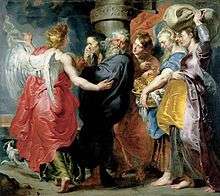
Inspired by Ruebens, Jordaens painted his iconoclastic duplicate in oils on an 66 by 78 inches (1,700 mm × 2,000 mm) canvas in 1620. Currently housed at The National Museum of Western Art in Tokyo, the Flemish painting depicts the tale found in the Book of Genesis.[18]
The Satyr and the Peasant
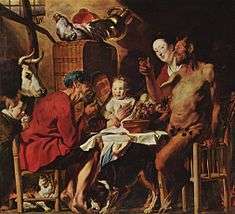
This particular scene, of which Jordaens painted many versions, illustrates a moralizing fable from Aesop's Fables. The story begins with a man and a satyr. One cold day, as they talked, the man put his fingers to his mouth and blew on them. When the satyr asked the reason for this, the man said that he did it to warm his hands. Later on, when they sat down to eat, the man raised his dish of hot food towards his mouth and blew on it. When the satyr again inquired the reason, he said that he did it to cool the food. The satyr then informs the man, "I can no longer consider you as a friend, a fellow who with the same breath blows hot and cold."[19] The moral of this story is the duality of human nature, although some believe that Jordaens chose this story not for his interest in its moral lesson, but for his interest in rendering a peasant scene.[20]
The particular moment which Jordaens depicts in his painting is when the satyr declares that he cannot trust the man. The man is eating while the satyr rises abruptly with raised hand prior to leaving the man's home.[21] Jordaens chooses to place the scene inside a farmhouse, complete with a bull, dog, cat, and rooster integrated around the furniture and figures. A variety of age groups are represented around the table; a young boy stands behind the man's chair, an old woman holds a young child, while a youthful woman peers over the Satyr's shoulder.
Characteristic of Jordaens' artistic style is the manner in which all the figures are pushed forward toward the front of the composition, crowded together in this small space. Jordaens uses tenebrism and chiaroscuro to create dramatic lighting, which illuminates certain figures in the scene, such as the baby in the old woman's lap. Jordaens creates a sense of naturalism with the depiction of the dirty feet of the seated peasant seated in the foreground, linking him with the Caravaggistic tendencies in Flemish art of the time. Jordaens created two versions of this subject around 1620–21.[21] For this version, it seems he may have used the same female sitter for The Satyr and the Peasant as he did for The Adoration of the Shepherds, and it is thought that Jordaens used this painting as instruction for his assistants and pupils, as many versions and copies of the scene have been found which bear the same style, but without the master's stamp.[22]
Candaules, Nyssia, and Gyges
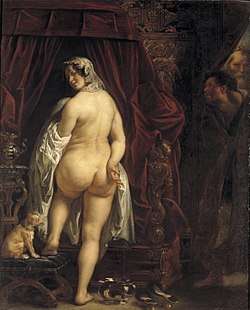
This image illustrates Herodotus's version of the tale of Gyges. The moral of this story is the duty of a husband to protect his wife. When he violates that duty tragedy will result; in this case Candaules dies. Jordaens chose this story for his interest in its moral lesson.
The particular moment which Jordaens depicts in his painting is when Nyssia, having finished disrobing, is getting into bed, and has not yet detected her violation. Both men are shown watching from hiding, a departure from the original story as told by Herodotus.
Jordaens placed the scene inside bedroom, complete with a dog, and toilet items, integrated around the furniture and figures.
Characteristic of Jordaens' artistic style is the use of tenebrism and chiaroscuro to create dramatic lighting, which illuminates Nyssia in the scene, highlighting her shoulders and buttocks. Jordaens creates a sense of naturalism with the depiction of the dog seated in the left foreground on the stool.
Self-portrait with Wife and Daughter Elizabeth
Here we see Jordaens with his wife Catherine van Noort, his eldest child Elizabeth and a servant. The painting has been dated around 1621–22 because Elizabeth appears to be about 4 years old and she was born in 1617.[23] Everyone in the painting is looking out at the viewer as if to invite them in to join the group. Jardin d'amour was an ancient tradition that Jordaens has represented in his family portrait.
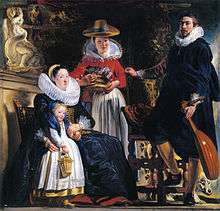
We see that he has also thrown a fair amount of symbolism into the painting to help give it meaning. "The intertwined vines behind the couple symbolize the inseparability of husband and wife."[23] Elizabeth is holding fruit in her hand which is symbolic of love and the flowers she has in her basket reflect innocence and purity."[23] In the upper left there is a perched parrot which depicts marital fidelity. Another animal located in the lower right is a dog representing faithfulness and trust."[23]
This is one of the first examples of RA-like findings in Dutch art. Little evidence of rheumatoid arthritis like disease was noted in art or skeletal remains before the 17th century in Europe and Northern Africa. Findings suggestive of rheumatoid arthritis appear in 17th century Dutch art. Detail from La Familia de Jordaens en un Jardín by Jacob Jordaens show swelling of the metacarpal-phalangeal and proximal interphalangeal joints.[24]
St. Peter Finding the Tribute Money
This work, most likely painted circa 1623 for the Amsterdam iron and weapons merchant Louis de Geer I, represents the story from Matthew 17: 24–27, in which Jesus tells Peter to catch a fish and inside he will find money to pay tribute in Capernaum. The composition is crowded, with the centre of action happening inside the boat. Peter and the other apostles are seen at the right side of the painting, peering down as Peter draws a fish from the water. These figures do not acknowledge the viewer. However, other figures look out of the painting at the viewer: the woman with her child and the man using an oar to launch the boat. Most figures, however, are consumed each in their own task, whether that be finding the fish, working to heave to and sail the boat, or sit as passengers awaiting the destination. The variety of human expression stems from Jordaens' studies of heads, many of which are recognizable from his other works.[25] The recent restoration treatment of the painting was accompanied by a large and fully illustrated book which goes very deep under the surface of the image and lays out the various approaches and results of the most recent research, giving a thorough picture of Jordaens, his works and his time.[26]
The Martyrdom of St. Apollonia
The church of St. Augustine, located in Antwerp, had three altars. Each altar held one large painting by either Rubens, van Dyck, or Jordaens. All three paintings were created in 1628.[27] Rubens' Madonna and Child Adored by Saints hung over the high or main altar in the centre. The altar on the left contained van Dyck's St. Augustine in Ecstasy, and finally Jordaens' The Martyrdom of St. Apollonia hung over the altar located to the right.[27] Jordaens' rendition of the martyrdom of St. Apollonia, who jumped into a fire rather than denounce her faith in the 3rd century, is crowded and dramatic. Rubens, van Dyck and Jordaens were Antwerp's greatest Baroque painters and the only time that these three painters collaborated simultaneously was during the commission of the church of St. Augustine. Together they tied the themes of each painting to one another.[27] Rubens' piece was of the Virgin surrounded by saints, van Dyck and Jordaens each painted saints which frame the Virgin. The saintly images invited the viewer to become closer to heaven and God through either martyrdom or monasticism.[27]
The Infant Jupiter Fed by the Goat Amalthea
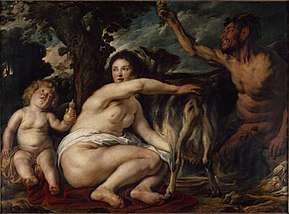
At the foot of a gentle slope, The Infant Jupiter Fed by the Goat Amalthea (1630–35) is set in a landscape. The focus of the composition is on the nymph Andrastea, whose pale nakedness is contrasted by the darker hues of the other figures. She sits on ground with her legs folded partly underneath her and a cloth draped around her hips. She has one hand on the back of the goat Amalethea and the other pulls on the goat's udder, squirting milk into a dish. The infant Jupiter sits behind her, holding an empty bottle and crying for food. In an attempt to distract Jupiter, a satyr pulls a branch. An engraving after the canvas by Schelte a Bolswert clarifies the moral significance of the subject: according to the Latin inscription on the print, the goat's milk Jupiter was fed as a child was responsible for the god's notorious infidelity.[28]
The King Drinks
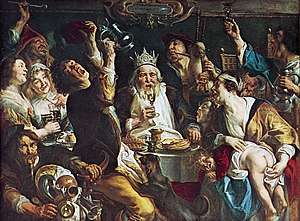
Jordaens painted several versions of this subject, including one c. 1640 work in the Royal Museum of Art, Brussels. Epiphany is celebrated in Flanders on 6 January. It is a celebration of food, wine and merriment that is shared with family. One person gets to be king for the evening, which as Jordaens thoughtfully depicts as the eldest person in the room. The rest of his subjects are assigned by him.[29] Jordaens also made another version of the painting as there are many paintings on this particular topic. In one version over 17 people are shown in the painting and they are all tightly packed together. In the other version they are closer to the picture plane and more spaced. The painting shows that emotions are running high, with people's extremely boisterous expressions.[29] There seems to be a brawl that is about to erupt and the expression of the man who is vomiting seems all too pitiful. Jordaens uses this painting to express his distaste for drunkenness with the motto inscribed at the top that translates "Nothing seems more like a madman than a drunkard."[30]
As the Old Sing, So the Young Pipe
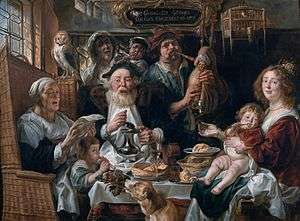
As the Old Sang, So the Young Pipe (c.1638–1640) is considered a companion to The King Drinks (Louvre, Paris). Both paintings are of a moralizing nature, have near identical measurements, and related styles.[31] As the Old Sang, So the Young Pipe shows three generations of wealthy Antwerp burghers sitting around a table making music. Being a popular theme among Jordaens and his clients, several versions of this painting were created. In the version shown Jordaens' father-in-law Adam van Noort is depicted as the old man. In this popular painting genre, elderly and middle-aged figures are always portrayed singing and creating music, as children "pipe" along.[31] The title is based on a popular proverb from the book Spiegel van den Ouden ende Nieuwen Tijdt, an Emblem book by Jacob Cats published in 1632. The Dutch proverb is Zo de ouden zongen, zo piepen de jongen, referring to the habit of birds to echo the pipe, or peeping chirp of their parents. Cats, a Calvinist, translated the proverb into a moralizing message; parents must be mindful of their actions and words, because children will copy their elders.[31] The Dutch word for peep is just as in English, very close to the word pipe, and in this version, the bagpipe and flute pipe are used, but in some versions, the children are portrayed smoking a pipe, which even in those days was considered unhealthy for children. Jan Steen also used a bagpipe and flute in his paintings on the same subject from around 1668 and 1670, even depicting the poem by Cats in the former of the two scenes. In his paintings however, Jordaens conveys this moralizing message as well as the idea that younger generations succeed their elders. The owl, considered the bird of the night, perched on the older woman's wicker chair, serves as a memento mori, a reminder of mortality.[31]
Prometheus
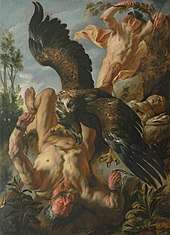
Jordaens's 1640 painting Prometheus(depictsof the mythological tale of the titan Prometheus who had his liver pecked out by an eagle each day only to regenerate and begin the cycle anew the next day.[32] Prometheus was punished for his audacity by Zeus for having given fire to man, not just in its physical form, but also in the fire of reason, which can be related to man's creativity in arts and sciences.[32] Jordaens' depiction is very much likened to Rubens Prometheus. Jordaens' positioning of the eagle, and backwards, heroically-nude bloodshot-eyed Prometheus, as well as the use of punishment and pain of man with spastic twisting and contorted movements, are also common themes in Rubens' version.[33]
The difference lies in the depiction of Hermes, which can be argued represents a note of optimism of being saved; as in other versions of the mythology, Hermes helps obtain Prometheus' release.[34] Still, in the Prometheus Bound attributed to Aeschylus, Hermes treats Prometheus badly, which would argue against an optimistic interpretation. The depiction of the sacks of bones (used in another part of the myth to deceive Zeus) and a clay statue (which represents his creation of man) are also not part of the Rubens painting.[34] Another notable difference is the look of pure agony in Jordaens' Prometheus while Rubens' figure relies on the suggestion of the contorted figure to convey the same feeling. Jordaens' Prometheus is a facial study, a prevalent subject found in Jordaens' paintings and from other artists during the same time.
Mercury and Argus
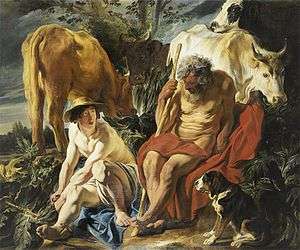
Mercury and Argus, painted circa 1620, depicts the a scene from the story of Mercury, Argus, and Io, found in The Metamorphoses written by Ovid (I, 583; IX, 687).
Jupiter (Zeus) falls in love with Io, a priestess of Hera, his wife, who quickly discovers the affair. Jupiter transforms himself into a bull and transforms Io into a beautiful, white heifer in order to hide from Hera's wrath. Hera understands his strategy and demands the heifer as a present. To end their affair, Hera puts Io under the guard of the giant Argus Panoptes, who has 100 eyes. Jupiter commands his son Mercury (Hermes) to set Io free by lulling Argus to sleep with an enchanted flute. Mercury, disguised as a shepherd, is invited by Argus to his camp. Mercury charms him with lullabies and then cuts his head off.[35] The painting is on display at the Museum of Fine Arts of Lyon.
Night Vision
Jordaens' Night Vision depicts a dark and gloomy scene of a young man tormented in his sleep by an apparition of a female nude. On the left hand side of the composition, an elderly woman and a younger woman crack open the door, peering in, and illuminating the room with soft candlelight. They appear to be astonished at the sight of the apparition. Jordaens emphasizes the temporality of this scene by allowing certain elements to stand out sharply against the overall dark ground of the painting. For instance, the sleeping boy has just clumsily knocked over a copper pot and a candlestick which now lie in the foreground of the painting. Special attention is also paid to fabrics in this work. Jordaens creates the sensation of wind with both the flowing white cloth held by the apparition and the billowing red garment worn by the old woman. Erwin Bielefeld asserts that this painting most likely depicts a story written by Phlegon of Tralles for the Roman Emperor Hadrian, of which Jordaens may have had access to a translation or could have adapted from a more contemporary version[36] The ancient story tells the tale of a young man, Marchete, who stays as a guest of a wealthy couple. During the night, Marchete's slumber is disturbed when he dreams of Philinion, the couple's deceased daughter. Grasping the cloth her corpse was wrapped in, Philinion in the guise of a vampire asks to bed with Marchete. Awoken by sounds coming from the room, Philinion's mother, Charito, comes to investigate with the aid of a maidservant. Upon entering the room, they are horrified by the sight of the deceased daughter.[37] Jordaens' Night Vision appears to be a very faithful representation of Phlegon's story and depicts the decisive moment or climax of the ancient tale. Influences evident in this image are common among the work of Jordaens. Most notably, Jordaens borrows the use of candlelight as a main light source from Elsheimer and the use of tenebrism to create drama from Caravaggio.[38]
The Story of Cupid and Psyche
Sometime during the years 1639–40, Jacob Jordaens received the commission to create a series of works for Charles I of England through Balthazar Gerbier, the King's agent in Brussels, and Cesare Alessandro Scaglia, a diplomat residing in Antwerp. The project entailed twenty-two paintings illustrating The Story of Cupid and Psyche (1640–41)[39] – van Dyck's Cupid and Psyche may also be related to the project. While the works were to be displayed in the Queen's House at Greenwich upon completion, the patron and final location were unknown to the artist.[40] As Jordaens submits his initial design to his intermediaries between himself and the English court, Gerbier continually attempts to convince the King that Rubens would be much more suited to a project requiring such substantial amounts of foreshortening.[41] His efforts are in vain, however, as Rubens dies on 30 May 1640. With Rubens' death, Jordaens bore sole responsibility for the entire commission.[42] Efforts to continue with the project continued slowly, and a year later, in May 1641, all plans for The Story of Cupid and Psyche series were disrupted, with the death of diplomat Scaglia. The project never fulfilled, only eight completed paintings made their way to the English Court, and a resulting dispute with Scaglia's heirs over payment for seven of these works continued into the next generation.[39]
Another version of the Story of Cupid and Psyche adorned the ceilings of Jordaens' house in Antwerp. At least nine decorated the ceiling of a salon in the South wing of the house, with Psyche Received by the Gods forming the centrepiece. Included in the series were Psyche's Father Questions the Oracle in the Temple of Apollo, The Love of Cupid and Psyche, The Curiosity of Psyche, Cupid's Flight, Psyche Received by the Gods and two putti pieces. The ceiling pieces are all foreshortenings, seen from below, and the perspective system was borrowed verbatim from Rubens' ceiling pieces in the Jesuit church in Antwerp. The paintings are viewed through an octagonal 'aperture' frame.[43] According to the inventory left by Jordaens' grandchildren, these paintings were part of the sale of the house in 1708.
Diana and Actaeon
Completed around 1640, this lavish and erotic version of the mythological tableau which is perhaps based on the better known 1556–59 version by Titian, depicts Actaeon bearing a phallic spear as a clear sexual threat to Diana and her court. It is in the collection of the Gemäldegalerie Alte Meister Dresden, but has become the artist's most "seen" painting by dint of its appearance in several films including the art conscious 1967 James Bond spoof, Casino Royale, where it hangs above the master's bed in "M"'s Scottish castle and is erroneously labelled a Titian, and more recently in the 2008 film on the von Stauffenberg assassination plot against Hitler, Valkyrie, where it appears in the mock up of the Grand Hall in Hitler's Bavarian Berghof (residence), a suggestion of looted art and the dictator's desire for old Germanic masters.
The Holy Family with Various Persons and Animals in a Boat
The style of Jacob Jordaens' mid-century painting can be clearly seen in The Holy Family with Various Persons and Animals in a Boat (1652). Nearing the age of sixty, Jordaens' paintings became more the work of his assistants following the direction of Jordaens, and the production of his work began to decline. He included great numbers of figures in his works, which became a heavy task for a 60-year-old. The palette used is monotonous, with variety from grayish-blue to brown. At times taking away from the rest of the painting and composition, the gestures of the figures are often self-contained while the bodies themselves are angular in form.[44]
The Triumph of Frederik Hendrik
.jpg)
Jordaens' painting, The Triumph of Frederik Hendrik, painted in 1651, portrays over fifty figures surrounding Stadholder Frederik Hendrik and his relatives. The piece was painted in honour of Stadholder Frederik Hendrik, Prince of Orange, and commissioned by his consort, Amalia van Solms. She was looking to commemorate the Stadholder after his death in 1647. The collection of work that was being assembled, as was common practice of the time, was meant to glorify the prince and his valiant deeds.[45] Instead of describing events, using straight forward images and icons, the collection was painted in allegories used to enthrone the Stadholder as heroic and virtuous.[46] It was displayed in Huis ten Bosch (House in the Woods), which began as a suburban retreat for Amalia van Solms (today a royal palace). The painting hangs in the Oranjezaal, the last remaining intact interior in Huis ten Bosch, covering much of the lower tier of the room as it is quite large and completely dominant in the room. Jordaens was chosen as he was highly respected as part of the Flemish trio that included Peter Paul Rubens and Anthony Van Dyck.[45]
Frederik Hendrik rides on a triumphal chariot, carried as a god, as bringer of peace and as one who has manifested prosperity shown in olive branches and cornucopias. On both sides of the painting are portraits of men carrying products from the West and East Indies. This makes the prince appear as if he is solely responsible for military victories as well as the immense wealth of the Republic.[46] The work was made with intensive complexity. Even today scholars discuss the many references Jordaens included in the painting. Many find it difficult to decode all of them. Overall it seems easy to gather the main message Jordaens included in the painting, however, it is filled with so many more symbolic people and figures that further explanation from the artist was needed by his contemporaries to understand all of the painting.[47]
The Eye of the Master Makes the Horse Fat
Jacob Jordaens had often used proverbs in his paintings, using the characters in the portrait to play out the meaning of the proverb (usually a warning of sorts). This technique made it easy to compare Jordaens with Pieter Bruegel, who often used proverbs. He saw it as a good way to expose the foolish and erring nature of man. Usually looking for a proverb with a positive, optimistic message, Jordaens would use his characters to explain the proverb's caution, explicitly or by implying the message. In The Eye of the Master Makes the Horse Fat, a horse is centred in the midst of flourishing prosperity begat by good management. Jordaens includes the god, Mercury, who takes a place in equine astrology with a salutary planetary influence on horses.[48]
In Spain there is an interesting set of his works. The Prado Museum preserves eleven works of his brush, including the mentioned Self-portrait with Wife and Daughter Elizabeth, another eight of which are mythological (including some from the Torre de la Parada Commission) one of Three strolling Musicians and a Pietà, in addition to a drawing and a gouache.[49] The Thyssen-Bornemisza Museum owns a Holy Family with an Angel[50] in which the participation of its workshop is also noticeable. The Royal Academy of Fine Arts of San Fernando has a Diana and Callisto[51] and in The Lázaro Galdiano Museum a canvas with Two Cherubs embraced is attributed to him.[52] The Bilbao Fine Arts Museum keeps a fragment of Jupiter's childhood titled: Satyr playing the Pipe[53] and a Head of a Peasant.[54]
 Three strolling Musicians, 1645-1650. Prado Museum, Madrid.
Three strolling Musicians, 1645-1650. Prado Museum, Madrid.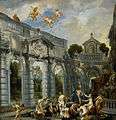 The Love of Cupid and Psyche, 1640-1650. Prado Museum, Madrid.
The Love of Cupid and Psyche, 1640-1650. Prado Museum, Madrid. Pietà, 1650-1660. Prado Museum, Madrid.
Pietà, 1650-1660. Prado Museum, Madrid._(fragment)_-_Google_Art_Project.jpg) Satyr playing the Pipe, Bilbao Fine Arts Museum, Bilbao.
Satyr playing the Pipe, Bilbao Fine Arts Museum, Bilbao.
Tapestry designs
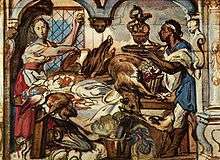
Jacob Jordaens' most significant body of work were the numerous designs he did for tapestries. As the most lucrative of the arts, tapestries were considered precious throughout the Renaissance and Baroque periods. These large wall hangings had begun to appear on the walls of wealthy European nobility in the fourteenth century.[55] Following the success of the Brussels tapestries woven after the Raphael cartoons, 16th and 17th-century patrons employed artists as tapestry designs; Jacob Jordaens, Peter Paul Rubens and Pietro Cortona flattered patrons allegorically in a manner that would identify them with famous historical or mythological figures, as a form of aristocratic self-promotion.[56] Jordaens found that he was particularly successful in the tapestry ventures. He was especially motivated in this field and his perfected techniques and style earned him numerous commissions for series of tapestries. He was seen as one of the leading tapestry designers of the era.[57]
Jordaens' process of tapestry creation included a preliminary drawing or sketch of the design. The design then is transferred to larger, more detailed oil sketch for the full-scale cartoon, which the weavers work from directly in weaving tapestry. Jordaens began planning a tapestry by executing a preparatory drawing coloured with water-soluble pigments. Although Jordaens did some sketches in oil, most were executed on paper or, later in his career, directly on canvas.[58] Jordaens' tapestries were made for the aristocracy who placed such high value on them they would carry them with them while they travelled or went on military campaigns as a symbol of their status.[59] Jordaens' scope of artistic representation was diverse, ranging from mythology, country life, to the history of Charlemagne.[60] It has been noted that Jordaens' tapestry design incorporated densely organized crowds of figures, packed into a flat two-dimensional picture plane emphasizing surface patterns which resulted in a "woven picture". Just as he liked to crowd his genre paintings he carried forward to his tapestries.[61]
The drawing done for the tapestry Interior of a Kitchen is an example of a part of the process used by Jacob Jordaens. He has used brown ink and applied colour over black chalk on paper to layout the still life on a table and how the figures were to be arranged. The final tapestry underwent changes, but the initial design which borrowed elements of still life paintings by the seventeenth century Antwerp artist Frans Snyders, was fairly closely adhered to.[62]
Drawings
Maintaining trends in Flemish painting, Jordaens was a proponent of extending Rubens' and Van Dyck's "painterly" style of art to his exceptionally prolific body of preparatory drawings. Today, approximately 450 drawings are attributed to Jordaens, however, there is continuing scholarly debate in terms of accurate attribution of Flemish drawings to Jordaens or Rubens, due to their similar oeuvre. Jordaens and his contemporaries were proponents of the Flemish trend towards making, expanding, and modifying preparatory drafts for larger paintings or to add to their visual vocabulary the classical artistic ideals. As a painter-draftsman, Jordaens often employed gouache and washes to his preparatory drawings, and was known to be extremely economical in his use of paper, as he never hesitated to add strips, cut away unwanted sections, or paste over existing work in order to achieve his desired effect.[5]
Allegory of April
The subject of this drawing (date unknown) has long been debated. The portrayal of a nude female figure atop a bull may quite possibly be an allusion to the story of the rape of Europa, with Europa as the female nude and Jupiter in the guise of the bull. The other argument surrounding the drawing's subject matter is that it may be an allegory of the month of April. If this is indeed the intended theme of the drawing, the bull would represent the zodiacal sign of Taurus, while the nude female, holding a bouquet of flowers, would be a depiction of Flora, the goddess of spring. The figures accompanying Flora would most likely be Ceres, goddess of agriculture, and Silenus, instructor and advisor to Bacchus.[63]
References
- Jacob Jordaens (I) in the Netherlands Institute for Art History
- d'Hulst, pp. 23
- d'Hulst, pp. 24–25.
- d'Hulst, p. 26–27.
- d'Hulst (2001)
- d'Hulst p. 23
- d'Hulst (1993), 23
- Nelson, 4.
- d'Hulst (1993), p.25-26
- Nelson
- Rooses, p245
- d'Hulst (1993), .
- Belkin,334
- d'Hulst (1993), p. 24
- Belkin, p. 334
- Vieghe, 262.
- Benedict, Philip (1999). "Calvinism as a Culture?". In Finney, Paul Colby (ed.). Seeing Beyond the Word. Grand Rapids, MI: Eerdmans. p. 36. ISBN 9780802838605.
- "Jacob Jordaens: 1593 – 1678." Markfm. Accessed 22 July. 2017. http://markfrm.blogspot.com/2014/12/jacob-jordaens-1593-1678-flemish.html?m=1
- Aesop
- Rooses (1908), p19
- d'Hulst (1993), 16
- Rooses (1908), p23
- d'Hulst (1993), 118
- Firestein, Gary S. (15 May 2003). "Evolving concepts of rheumatoid arthritis". Nature. 423 (6937): 356–361. doi:10.1038/nature01661. PMID 12748655.
- d'Hulst (1993), p.114;
- Articles by: Troels Filtenborg, Lars Hendrikman, Badeloch Noldus, Karsten Ohrt, Eva de la Fuente Pedersen, Annefloor Schlotter, Johanneke H. Verhave, and Jørgen Wadum. Jordaens. The Making of a Masterpiece, 2008. ISBN 978-87-92023-26-1
- d'Hulst (1993), p. 134
- d'Hulst (1993), p.154.
- d'Hulst (1993), p. 196.
- d'Hulst (1993), p. 198
- d'Hulst (1993), p. 182
- d'Hulst (1993), p. 184
- d'Hulst (1993), p. 184,186
- d'Hulst (1993), p. 186
- Metamorphoses (tr. Garth, Dryden, et al.), Book I, The Eyes of Argus transform'd into a Peacock's Train
- Bielefeld, 178.
- Bielefeld, 177.
- d'Hulst, 83.
- d'Hulst, 26.
- d'Hulst, 10, 26.
- d'Hulst, 10.
- d'Hulst, 26
- Belkins, 260.
- d'Hulst (1993), p. 6
- Rosenberg, p. 232-233
- Westermann, p. 39
- Rosenberg, p. 233
- Westermann, p.
- "Jordaens, Jacques - The Collection - Museo Nacional del Prado". www.museodelprado.es. Retrieved 29 March 2020.
- "The Holy Family with an Angel". Museo Nacional Thyssen-Bornemisza. Retrieved 29 March 2020.
- Fernando, Real Academia de BBAA de San. "Jordaens, Jacob - Diana y Calisto". Academia Colecciones (in Spanish). Retrieved 29 March 2020.
- "Red Digital de Colecciones de Museos de España - Museos". ceres.mcu.es (in Spanish). Retrieved 29 March 2020.
- "The online collection and picture sale | The Bilbao Fine Arts Museum". www.museobilbao.com. Retrieved 29 March 2020.
- "The online collection and picture sale | The Bilbao Fine Arts Museum". www.museobilbao.com. Retrieved 29 March 2020.
- Nelson,6
- Nelson, 6
- Hulst, 24–25
- Nelson, 7
- Nelson,12
- Nelson,15
- Nelson, 16
- Nelson, 90
- Held, 443.
Sources

- Aesop, "The Man and the Satyr"
- Bielefeld, Erwin: Jordaens' Night Vision, in: Journal of the Warburg and Courtauld Institutes, Vol. 23, No. 1/2. (Jan.-Jun. 1960), pp. 177–178.
- Held, Julius S.: Jordaens' Allegory of April, in: Master Drawings, Vol. 19, No. 4. (Winter 1981), pp. 443–444, 486–487.
- d'Hulst, Roger-Adolf, Nora de Poorter, and M. Vandenven: Jacob Jordaens. 1593–1678, Antwerp, Koninklijk Museum Voor Schone Kunsten, 27 March – 27 June 1993, Catalogue. Gemeentekrediet, 1993.
- d'Hulst, Roger-Adolf: Jordaens, Jacob, in: The Oxford Companion to Western Art, Ed. Hugh Brigstocke, Oxford University Press, 2001. Gove Art Online. Oxford University Press, 2005. [20 Oct 2007].
- Münch, Birgit Ulrike / Pataki, Zita Ágota (Eds.): Jordaens. Genius of Grand Scale – Genie großen Formats, in collaboration with Elsa Oßwald u. Sarah-Sophie Riedel, Stuttgart 2012.
- Nelson, Kristi. Jacob Jordaens Design for Tapestry, Brepols 1998.
- Rooses, Max: Jacob Jordaens, London: J.M. Dent & Co., 1908.
- Westermann, Mariet: A Worldly Art: The Dutch Republic 1585–1718.
- Filippo Baldinucci's Artists in biographies by Filippo Baldinucci, 1610–1670, p. 197[1]
External links
| Wikimedia Commons has media related to Jacob Jordaens. |
- Comprehensive site with biography, images by the artist, and more.
- An Unexpected Classical Source for Jacob Jordaens
- Vermeer and The Delft School, a full text exhibition catalogue from The Metropolitan Museum of Art, which contains material on Jacob Jordaens
- Jacob Jordaens on BALaT – Belgian Art Links and Tools (KIK-IRPA, Brussels)
- Jordaens Van Dyck Panel Paintings Project
- Baldinucci, Filippo (7 April 1681). "Notizie de' professori del disegno da Cimabue in qua,: per le quali si dimostra come, e per chi le bell' arti di pittura, scultura, e architettura lasciata la rozzezza delle maniere greca, e gottica, si siano in questi secoli ridotte all'antica loro perfezione". Per Santi Franchi. Retrieved 7 April 2018 – via Google Books.